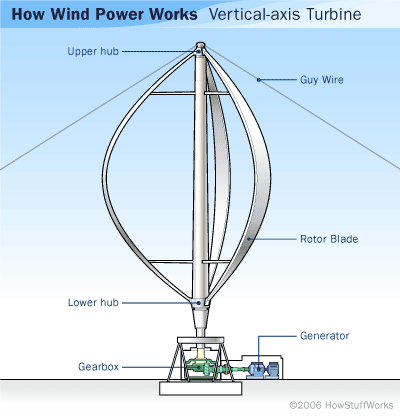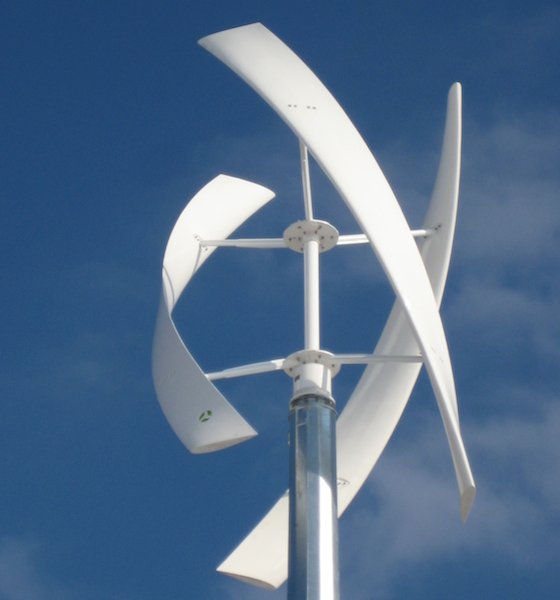Wind Energy part 1: Turbine basics
Wind is simply air shifting in the atmosphere from a place of high pressure to a place of low pressure. Ultimately, the energy that drives all meteorological processes, including wind, comes from the sun, so until the sun eventually stops shining, we’ll always have wind energy.
There are a number of different designs of turbine for extracting wind energy, but these can mostly be put into two classes: Vertical and horizontal axis turbines
Vertical axis turbine

[Darrieus rotor, an early vertical axis design]

[Similar to the Darrieus rotor, but the helical design reduces torque ripple]
Advantages of vertical axis turbines is that their gearbox and generator can be positioned at the bottom of the structure, which makes servicing easier. They also do not need to be pointed towards the wind, as they function unidirectionally. This saves them needing wind sensors to optimise their wind capture. They do however have some issues with torque ripple (solved with newer designs) and large forces on the blades. Other designs negate these drawbacks, but aren’t as efficient as horizontal designs.
Horizontal axis turbine

[Diagram of the top of a horizontal axis turbine]

[classic 3-blade horizontal axis turbine]
Advantages of horizontal axis turbines are their high efficiencies, scalability, and with modern manufacturing, their cost. However, they do require sensing equipment to direct their blades into the optimum wind direction, and they also are more difficult to service, however these disadvantages are offset by the design benefits.
So, how do these turbines work? The blades are shaped so that as air flows over them, they generate lift - just like an aeroplane wing. The generated lift pushes them around their axis of rotation. This rotation is put through a gearbox to increase its rate of rotation into the generator, which generates the electricity.
The wind will of course change direction from day to day, so to ensure the turbine can collect as much wind as possible, a sensor on the top of the nacelle measures wind direction and rotates the wind-facing side of the blade assembly accordingly.
One complaint against wind turbines I’ve heard on more than one occasion is that ‘they don’t work if it’s too windy’. What is meant by this is that the turbines have a maximum wind speed at which they will begin to shed power by pitching their blades into a less efficient angle. This is in fact crucial as it prevents this from happening:
All turbines have a cut-in wind speed, the speed at which the lift generated by the blades will overcome their own inertia, and a cut-out wind speed, where they have to shed power as described earlier. The wind speed where they can generate the most power is when the turbines operate at their peak efficiency and therefore their maximum power output. This is the nameplate power capacity given to the turbines that the manufacturers will advertise them with.
So how do we calculate the power of a wind turbine? With this simple equation:
P = 0.5 × A × ρ × V
Where P = power output, A = the swept area of the turbine blades (ie the area of the circle they draw as they rotate) , ρ = the density of the air and V = the wind’s velocity. This however doesn’t account for the device efficiencies and Betz’ limit. To include these the equation becomes:
P = 0.5 × A × ρ × V × Cp × Ng × Nb
Where Cp = the power coefficient of the device in question, Ng = the generator efficiency and Nb = the gearbox efficiency. This equation will give an accurate figure for a turbine’s power output. Power coefficient and Betz’ limit is an article in itself, which I may write about in the future, but in the meantime if you’re curious give them a Google as they’re very important to any turbine operating in a fluid!
That rounds up part one of wind turbines, next comes how we attach them to the ground, and deploy them in the ocean. Follow worldcast if you want to know more about renewable energy and please consider upvoting and resteeming this article if you enjoyed it! Thanks for reading!
Image sources:
https://urjart.files.wordpress.com/2008/10/darrieusrotor.gif
https://cleantechnica.com/files/2014/04/VIsionAIR5-micro-wind-turbine.jpg
http://windeis.anl.gov/guide/basics/turbine.html?tag=movipersonal-20
http://www.mechanicalengineeringblog.com/wp-content/uploads/2011/04/01wind_450KW_turbine.jpg
Congratulations @worldcast! You received a personal award!
Click here to view your Board
Do not miss the last post from @steemitboard:
Congratulations @worldcast! You received a personal award!
You can view your badges on your Steem Board and compare to others on the Steem Ranking
Vote for @Steemitboard as a witness to get one more award and increased upvotes!
Hey the post looks good but I was wondering if yo could add some reference material for the information, as well make certain that images aren't copywrite (I am not certain if these are or not, just in case though)
A good way is to search on google images and click on tools, usage rights, and down to labeled for reuse.
Hi, thanks for the interest, i'll check that stuff and update the post by tomorrow. Thanks for the tips!